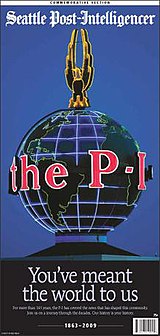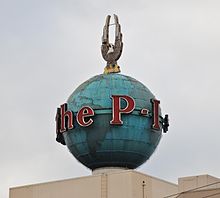Seattle Post-Intelligencer
 | |
 Former P-I headquarters atMyrtle Edwards Park | |
| Type | Online newspaper |
|---|---|
| Format | Broadsheet(until 2009) |
| Owner(s) | Hearst Communications |
| Founded | December 10, 1863 |
| Headquarters | 2901 3rd Ave, Ste 120 Seattle,Washington,U.S. |
| ISSN | 0745-970X |
| OCLCnumber | 3734418 |
| Website | seattlepi |
TheSeattle Post-Intelligencer(popularly known as theSeattle P-I,thePost-Intelligencer,or simply theP-I) is anonline newspaperand former print newspaper based inSeattle,Washington,United States.
The newspaper was founded in 1863 as the weeklySeattle Gazette,and was later published daily inbroadsheetformat. It was long one of the city's two daily newspapers, along withThe Seattle Times,until it became an online-only publication on March 18, 2009.
History[edit]


of the last printed edition
of theSeattle Post-Intelligencer,
published on March 17, 2009.
J.R. Watson founded theSeattle Gazette,Seattle's first newspaper, on December 10, 1863.[1][2]The paper failed after a few years and was renamed theWeekly Intelligencerin 1867 by new owner Sam Maxwell.[3]
In 1878, after publishing theIntelligenceras a morning daily, printerThaddeus Hanfordbought theDaily Intelligencerfor $8,000. Hanford also acquiredBeriah Brown's dailyPuget Sound Dispatchand the weeklyPacific Tribuneand folded both papers into theIntelligencer.In 1881, theIntelligencermerged with theSeattle Post.The names were combined to form the present-day name.[2]
In 1886, Indiana businessmanLeigh S. J. Huntcame to Seattle and purchased theSeattle Post-Intelligencer,which he owned and published until he was forced to sell in thePanic of 1893.[4]At this point the newspaper was acquired by attorney and real estate developerJames D. Hogeunder whom it was representative of an establishment viewpoint. It was the state's predominant newspaper. Circulation was greatly increased by coverage of theKlondike Gold Rushin 1897. Hoge, who was involved in other business, sought to find a buyer and sold in 1899. The newspaper was acquired with assistance fromJames J. HillbyJohn L. Wilsonwho had first started the Seattle Klondike Information Bureau. The newspaper was acquired by Hearst in 1921.
Circulation stood at 31,000 in 1911.[1]In 1912, editor Eric W. Allen left the paper to found theUniversity of OregonSchool of Journalism, which he ran until his death in 1944.[5]
William Randolph Hearsttook over the paper in 1921, and theHearst Corporationowns theP-Ito this day.[2]
In 1936, 35P-Iwriters and members ofThe Newspaper Guildwent onthree-month strikeagainst "arbitrary dismissals and assignment changes and other 'efficiency' moves by the newspaper." TheInternational Brotherhood of Teamstersjoined the strike in solidarity.[6]Roger Simpson and William Ames co-wrote their bookUnionism or Hearst: the Seattle Post-Intelligencer Strike of 1936on the topic.[7]
Anna Roosevelt Halsted,the daughter ofFranklinandEleanor Roosevelt,began working as the editor of thewomen's pageat theP-Iafter her husbandClarence John Boettigertook over as publisher in 1936. Boettiger left Seattle to enter theUnited States Armyin April 1943, while Anna stayed at the paper to help keep a liberal voice in the running of the paper. After Boettiger's absence, the paper increasingly turned conservative with Hearst's new acting publisher. Anna left Seattle in December 1943 to live in the White House with her youngest child, Johnny. This effectively ended the Roosevelt-Boettiger ties with theP-I.[8]
On December 15, 2006, no copies were printed as a result of a power outage caused by theDecember 2006 Pacific Northwest storms.It was the first time in 70 years that publication had been suspended.[9]
On January 9, 2009, the Hearst Corporation announced that after losing money on it every year since 2000, Hearst was putting theP-Iup for sale.[10][11]The paper would be put on the market for 60 days, and if a buyer could not be found within that time, the paper would either be turned into an Internet-only publication with a drastically reduced staff, or closed outright.[10][11]The news of the paper's impending sale was initially broken by local stationKING-TVthe night prior to the official announcement, and came as a surprise to theP-I's staff and the owners of rival newspaperThe Seattle Times.Analysts did not expect a buyer to be found, in view of declining circulation in the U.S. newspaper industry and other newspapers on the market going unsold.[10]Five days before the 60-day deadline, theP-Ireported that the Hearst Corporation had given severalP-Ireporters provisional job offers for an online edition of theP-I.[12]
On March 16, 2009, the newspaper posted a headline on its front page, followed shortly after by a short news story, that explained that the following day's edition would be its final one in print.[13]The newspaper's publisher, Roger Oglesby, was quoted saying that theP-Iwould continue as an online-only operation. Print subscribers had their subscriptions automatically transferred toThe Seattle Timeson March 18.
As of 2024[update],theP-Icontinues as an online-only newspaper. In September 2010, the site had an estimated 2.8 million unique visitors and 208,000 visitors per day.[14]
Joint operating agreement[edit]
From 1983 to 2009, theP-IandThe Seattle Timeshad ajoint operating agreement(JOA) wherebyadvertising,production,marketing,and circulation were run for both papers byThe Seattle Timescompany. They maintained separatenewsandeditorialdepartments. The papers published a combined Sunday edition, although theTimeshandled the majority of the editorial content while theP-Ionly provided a small editorial/opinions section.[citation needed]The JOA was proposed by Hearst in 1981 due to $14 million in cumulative financial losses incurred by theP-I.[15]
In 2003 theTimestried to cancel the JOA, citing a clause in it that three consecutive years oflosseswere cause for cancelling the agreement.[16]Hearst disagreed, and immediately filed suit to prevent theTimesfrom cancelling the agreement. Hearst argued that aforce majeureclause prevented theTimesfrom claiming losses in 2000 and 2001 as reason to end the JOA, because they resulted from extraordinary events (in this case, a seven-week newspaperstrike).
Each side publicly accused the other of attempting to put its rival out of business. The trial judge granted a summary judgment in Hearst's favor on theforce majeureissue. But after two appeals, theWashington State Supreme Courtruled in favor of theTimeson June 30, 2005, on theforce majeureclause, reversing the trial-court judge. The two papers settled the issue on April 16, 2007.
The JOA ended in 2009 with the cessation of theP-Iprint edition.[13]
Awards[edit]
TheP-Iwas notable for its two-timePulitzer Prize-winningeditorial cartoonist,David Horsey.[17]
Notable reports[edit]
Report on Judge Gary Little[edit]
Investigative reporting onKing County Superior CourtJudgeGary Little's out-of-court contact with juvenile defendants revealed accusations that Littlemolestedyoung boys while he was a teacher at Seattle's exclusiveLakeside Schoolbetween 1968 and 1971. It also revealed inappropriate contact between Little and juveniles appearing before him after he became a judge. On August 19, 1988, after reporter Duff Wilson called the judge to advise him the newspaper was publishing the story, Little shot himself in theKing County Courthouse.Theethical debatessurrounding the publication of the story – and the network of connections that protected Little – are taught injournalismclasses, and led to reforms in the way judges are disciplined in Washington state.
Conduct Unbecoming series[edit]
In 2006 theP-Ibecame the subject of a complaint to theWashington News Councilfor its reporting on theKing CountySheriff's Office.The media watch-dog group ruled against theP-I,agreeing with Sheriff Sue Rahr's complaint that the newspaper had unfairly disparaged the Sheriff's Office.[18]TheP-Ideclined to participate in the proceedings, and opted instead to give a detailed reply on its website.[19]
The P-I Globe[edit]

TheP-Iis known for the 13.5-ton, 30-foot (9.1 m)neonglobe atop its headquarters on theElliott Baywaterfront, which features the words "It's in the P-I" rotating around the globe and an 18-foot (5.5 m) eagle perched atop with wings stretched upwards.[20]The globe originated from a 1947 readers' contest to determine a new symbol for the paper. Out of 350 entrants, the winner was Jack (known as Jakk) C. Corsaw, a University of Washington art student.[21]The globe was manufactured in 1948[21]and was placed atop the paper's then-new headquarters building at 6th Avenue and Wall Street (nowCity University of Seattle). When the newspaper moved its headquarters again in 1986 to its current location on the waterfront, the globe was relocated to the new building.[20]Over the decades since its first installation, the globe has become a city landmark that, to locals, is as iconic as theSpace Needle.[citation needed]A stylized rendering of the globe appeared on the masthead of the newspaper in its latter years and continues to feature on its website.[22]
In April 2012, it was designated a Seattle landmark by the city'sLandmarks Preservation Board.[21][23]MayorEd Murraysigned a city ordinance that had been passed by theSeattle City Councilon December 17, 2015, that designated the globe as an official city landmark.[24][25][26][27]
In March 2012, the globe was donated to theMuseum of History and Industry,which planned to refurbish and relocate it,[28]but as of 2018[update],this had not occurred.
Notable employees[edit]
Notable employees of theP-Ihave included two-timePulitzer Prizewinning editorial cartoonist and commentatorDavid Horsey,two-time Pulitzer Prize winning investigative reporterEric Nalder,Pulitzer Prizewinning journalist and authorTimothy Egan,journalist and author Darrell Bob Houston ( "King of the Midnight Blue," a novel loosely based on the noted highjacking byD.B. Cooper), the novelistsE. B. White,Frank Herbert,Tom Robbins,Adam Schefter andEmmett Watson,as well asAndrew Schneider,who won two Pulitzer Prizes for specialized reporting and public service while working atThe Pittsburgh Press.[29]
See also[edit]
- Hutch Award(baseball award bestowed atP-I's annual "Sports Star of the Year" banquet)
References[edit]
- ^ab"Character of P-I's content changed as Seattle grew up".Seattle Post-Intelligencer.RetrievedMay 21,2007.[dead link]
- ^abc"Intelligencer newspaper founded in Seattle in 1867".HistoryLink.org.RetrievedMay 21,2007.
- ^"The Seattle Post-Intelligencer".Washington State Library.RetrievedNovember 21,2017.
- ^"Seattle Post-Intelligencer (1863–2009)",HistoryLink.org
- ^Floyd J. McKay."Eric W. Allen".The Oregon Encyclopedia.
- ^"Seattle Post-Intelligencer Newspaper Guild Strike 1936".historylink.org.
- ^Roger A. Simpson Papers.1933–1994. 2.42 cubic feet (3 boxes), 15 sound tape reels.
- ^Boettiger, John(1978).A Love in Shadow.New York City: W. W. Norton & Company. pp.279.ISBN0-393-07530-3.
- ^Lynn, Adam (December 16, 2006)."With power out, Seattle papers use News Tribune's presses".The News Tribune.Archived fromthe originalon March 27, 2007.RetrievedMay 21,2007.
- ^abcPerez-Pena, Richard (January 9, 2009)."Hearst Looks to Sell, or Close, Seattle Paper".The New York Times.RetrievedJanuary 9,2009.
- ^abRichman, Dan; James, Andrea (January 9, 2009)."For sale: The P-I".Seattle Post-Intelligencer.RetrievedJanuary 24,2017.
- ^Richman, Dan (March 5, 2009)."Hearst makes offers to staff online-only P-I".Seattle Post-Intelligencer.RetrievedMarch 6,2009.
- ^abRichman, Dan; James, Andrea (March 16, 2009)."Seattle P-I to publish last edition Tuesday".Seattle Post-Intelligencer.
- ^seattlepi "Quantcast Audience Profile",quantcast,September 2010
- ^Friendly, Jonathan (July 2, 1981)."A Seattle Paper is Focus of Fight".The New York Times.p. D18.RetrievedJune 25,2024.
- ^Richman, Dan; Wong, Brad (April 17, 2007)."Seattle P-I and Times settle legal dispute".Seattle Post-Intelligencer.RetrievedMay 21,2007.
- ^"David Horsey Bio".Seattle Post-Intelligencer.Archived fromthe originalon November 20, 2008.RetrievedMay 27,2008.
- ^Ouchi, Monica Soto (October 22, 2006)."Council rules against P-I over sheriff's complaint".The Seattle Times.RetrievedMay 21,2007.
- ^"Panel: P-I unfair to Sheriff's Office".Seattle Post-Intelligencer.October 23, 2006.RetrievedMay 21,2007.
- ^abThompson, Lynn (March 22, 2011)."Push to keep P-I globe spinning".The Seattle Times.RetrievedMarch 8,2021.
- ^abc"Report on Designation: Seattle Post-Intelligencer P-I Globe"(PDF).The City of Seattle Landmarks Preservation Board. 2012. Archived fromthe original(PDF)on March 24, 2014.RetrievedJanuary 24,2017.
- ^Barry, Dan (March 16, 2009)."In Seattle, the World Still Turns, a Beacon in Memory of a Lost Newspaper".The New York Times.
- ^Harthorne, Michael (April 19, 2012)."It's official: P-I Globe is a Seattle landmark".KOMO-TV.Archived fromthe originalon September 7, 2014.RetrievedJanuary 24,2017.
- ^Seattle City Council(December 17, 2015)."City of Seattle Ordinance 118584".Office of the City Clerk.RetrievedJanuary 10,2016.
- ^Burton, Lynsi (December 17, 2015)."P-I globe now a city landmark".Seattle Post-Intelligencer.RetrievedJanuary 10,2016.
- ^"P-I Globe designated a City landmark".Office of the Mayor of Seattle. December 17, 2015.RetrievedJanuary 10,2016.
- ^Goldsmith, Steven (December 17, 2015)."19 tons of 'Daily Planet' — P-I Globe becomes official Seattle landmark".Puget Sound Business Journal.RetrievedJanuary 10,2016.
- ^Harthorne, Michael (March 7, 2012)."MOHAI plans to relocate newly acquired PI Globe".KOMO-TV.Archived fromthe originalon January 16, 2013.
- ^McCumber, David."Two-time Pulitzer winner Schneider dies at 74".Montana Standard.RetrievedMarch 16,2017.
External links[edit]
![]() Media related toSeattle Post-Intelligencerat Wikimedia Commons
Media related toSeattle Post-Intelligencerat Wikimedia Commons
- Official website

- Digitized copies of theGuild Daily,published by strikingPost-Intelligenceremployees in 1936, fromthe Labor Press Project.
- Newspapers published in Seattle
- Hearst Communications publications
- Newspapers established in 1863
- Publications disestablished in 2009
- Defunct newspapers published in Washington (state)
- Online newspapers with defunct print editions
- American news websites
- 1863 establishments in Washington Territory
- 2009 disestablishments in Washington (state)
